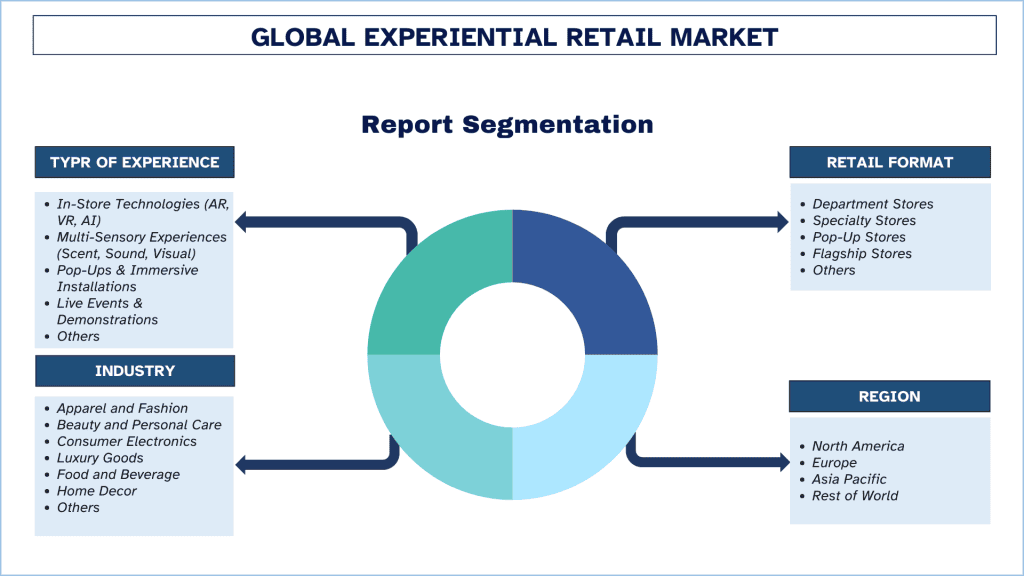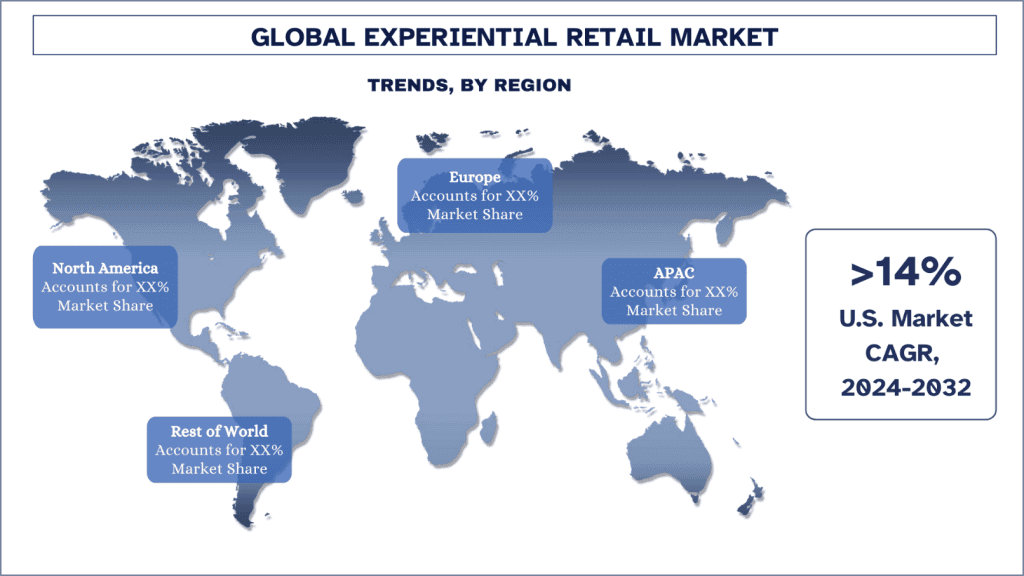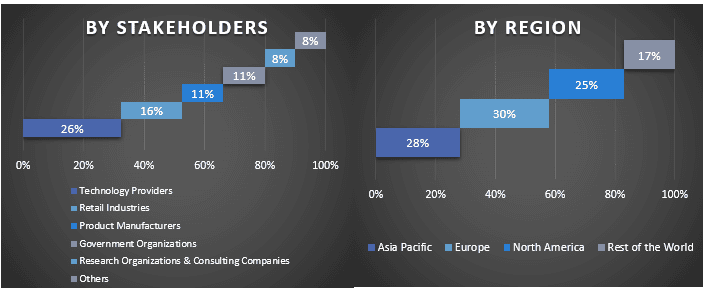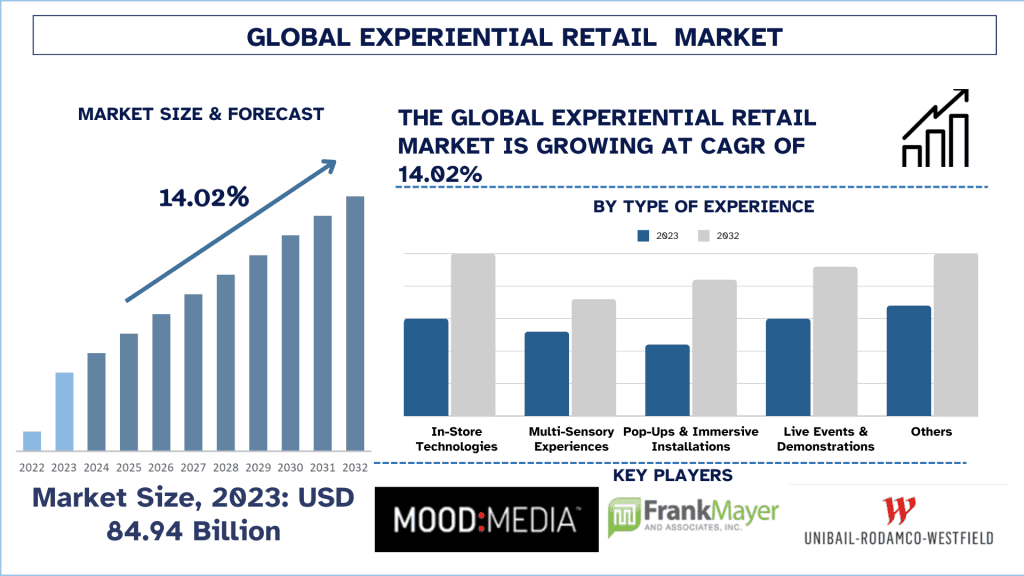- Home
- About Us
- Industry
- Services
- Reading
- Contact Us
Experiential Retail Market: Current Analysis and Forecast (2024-2032)
Emphasis on Type of Experience (In-Store Technologies (AR, VR, AI), Multi-Sensory Experiences (Scent, Sound, Visual), Pop-Ups & Immersive Installations, Live Events & Demonstrations, and Others); Retail Format (Department Stores, Specialty Stores, Pop-Up Stores, Flagship Stores, and Others); Industry (Apparel and Fashion, Beauty and Personal Care, Consumer Electronics, Luxury Goods, Food and Beverage, Home Decor, and Others); and Region/Country
Experiential Retail Market Size & Forecast
The experiential retail market was valued at approximately USD 84.94 billion in 2023 and is expected to grow at a considerable CAGR of around 14.02% during the forecast period (2024-2032) owing the rising need for retail quest and incorporating new technologies into shopping facilities.
Experiential Retail Market Analysis
The experiential retail industry has shown healthy growth by providing curated shopping experiences through a convergence of digital and physical worlds. Current theoretical approaches can provide significant insights into how major retailers are using experiential retail solutions as a competitive advantage against e-commerce rivals. For example, Nike opened a new House of Innovation store in Seoul that will apply some new AI and AR technologies to provide personalized shopping experiences. The store has various installations such as interactive, virtual fitting and customization stations which gives one a feeling of the future retail experience. Thus, the company increased customers’ attraction by 25% and proved that over 40% of customers in stores containing the AE components made purchases, which is double the figure in relation to traditional veneer. Further, customer intimacy and retention have become key growth priorities to drive an experienced economy, creating even higher demand for experiential retail solutions. The retail industry report on the stores that have incorporated elements of experience shows an average of 40% increase in dwell time for the customers and sales were up by 30% more than in traditional stores.
Recent Developments in the Market:
In March 2023, Apple had launched its enormous store in Mumbai, India, with zones and sessions such as Today at Apple, multiproduct installations, and brand experiences to enhance experiential retail in developing countries.
In April 2022, Zara’s new store in Madrid: Plaza de España, has technologies such as pay and go, fitting room booking and an online orders robotic pick up. An eco-efficient store contributes towards sustainability and has been designed to meet the BREEAM certification. Some of the sections that Zara’s Lingerie, Beauty, Athleticz and Origins’ outer garments dedicated spaces where there is no barrier between physical and click and mortar through Inditex Open Platform for instant customer response time were displayed. Concerning its design features, there are energy efficient systems in use, LED lighting, recycling program among others.

Experiential Retail Market Trends
AI-Driven Personalization and Predictive Analytics
There are various trends in the experiential retail market where the use of AI is highly relevant; one of them is personalization. These AI applications are revolutionizing the way almost all brands engage with consumers, prescriptive selling, dynamic pricing, and real-time data analysis for the consumer’s benefit and for more sales. In the recent study on some of the consumer demand forecasts using Gallup data, information was included from NASDAQ, product/brand lookups, underemployment, and standard-of-living pointers. By integrating the data types, Gallup developed a more accurate consumer demand model for its client than the prior consumer model by over 150%.
To drive personalization in sales, H&M integrated an artificial intelligence for interaction with the customers in its New York shop where it offered appropriate sizes of clothes, style preferences and suggestions for interaction based on previous data collected. This system has the policy of minimizing return rates and increasing the convenience of the stores. Also, H&M, the Swedish fashion giant, uses artificial intelligence and over 200 analysts to forecast and explain phenomena.
In June 2022, IKEA made an AI-powered VR tool for the customer to understand how the furnishing items would look like when placed at home. This tool is one more step in the development of IKEA’s digital capabilities and enhances customer decision-making experience. IKEA Kreativ has 20 years of knowledge and experience of life at home along with the newest trends in spatial computing, machine learning and 3D mixed reality.
North America is expected to dominate the market during the forecast period
North America held the majority share of the market in the year 2023. The major factors contributing to the growth of the market include the strong presence of major retailers of various industries such as fashion and apparel, consumer electronics, luxury goods, food and beverages, and home decor. These industries have a high adoption rate of in-store technologies to embrace new retail experiences. Major players in the market are investing heavy amounts in the upgradation of the retail stores, which ultimately scaling up the experiential retail market. For instance, in March 2022, Target Corporation announced its plan to invest up to $5 billion to continue scaling its operations in 2022. Target will invest in its physical stores, digital experiences, fulfillment capabilities and supply chain capacity that further differentiate its retail offering and drive continued growth. Additionally, the region is the home of some of biggest technology-driven companies which have seen a significant growth in the past couple of years, such as Amazon Style stores featuring AI-powered personalization and smart fitting rooms. Therefore, amongst areas, North America held a significant share of the market in the year 2023.

Experiential Retail Industry Overview
The experiential retail market is competitive, with several global and international market players. The key players are adopting different growth strategies to enhance their market presence, such as partnerships, agreements, collaborations, geographical expansions, and mergers and acquisitions. Some of the major players operating in the market are Mood Media, Frank Mayer and Associates, Inc., UNIBAIL-RODAMCO-WESTFIELD, Selfridges & Co., RetailNext, Inc., Snap Inc., Adobe, Salesforce, Inc., NCR Voyix Corporation, and Toshiba Global Commerce Solutions.
Experiential Retail Market Report Coverage
Report Attribute | Details |
Base year | 2023 |
Forecast period | 2024-2032 |
Growth momentum | Accelerate at a CAGR of 14.02% |
Market size 2023 | USD 84.94 billion |
Regional analysis | North America, Europe, APAC, Rest of the World |
Major contributing region | North America is expected to dominate the market during the forecast period. |
Key countries covered | The US, Canada, Germany, United Kingdom, Spain, Italy, France, China, Japan, and India |
Companies profiled | Mood Media, Frank Mayer and Associates, Inc., UNIBAIL-RODAMCO-WESTFIELD, Selfridges & Co., RetailNext, Inc., Snap Inc., Adobe, Salesforce, Inc., NCR Voyix Corporation, and Toshiba Global Commerce Solutions |
Report Scope | Market Trends, Drivers, and Restraints; Revenue Estimation and Forecast; Segmentation Analysis; Demand and Supply Side Analysis; Competitive Landscape; Company Profiling |
Segments Covered | By Type of Experience; By Retail Format; By Industry; By Region/Country |
Reasons to buy this report:
- The study includes market sizing and forecasting analysis validated by authenticated key industry experts.
- The report presents a quick review of overall industry performance at one glance.
- The report covers an in-depth analysis of prominent industry peers with a primary focus on key business financials, product portfolios, expansion strategies, and recent developments.
- Detailed examination of drivers, restraints, key trends, and opportunities prevailing in the industry.
- The study comprehensively covers the market across different segments.
- Deep dive regional level analysis of the industry.
Customization Options:
The global experiential retail market can further be customized as per the requirement or any other market segment. Besides this, UMI understands that you may have your own business needs, hence feel free to contact us to get a report that completely suits your requirements.
Table of Content
Research Methodology for the Experiential Retail Market Analysis (2024-2032)
Analyzing the historical market, estimating the current market, and forecasting the future market of the global experiential retail market were the three major steps undertaken to create and analyze the adoption of experiential retails in major regions globally. Exhaustive secondary research was conducted to collect the historical market numbers and estimate the current market size. Secondly, to validate these insights, numerous findings and assumptions were taken into consideration. Moreover, exhaustive primary interviews were also conducted, with industry experts across the value chain of the global experiential retail market. Post assumption and validation of market numbers through primary interviews, we employed a top-down/bottom-up approach to forecasting the complete market size. Thereafter, market breakdown and data triangulation methods were adopted to estimate and analyze the market size of segments and sub-segments of the industry pertains to. Detailed methodology is explained below:
Analysis of Historical Market Size
Step 1: In-Depth Study of Secondary Sources:
A detailed secondary study was conducted to obtain the historical market size of the experiential retail market through company internal sources such as annual reports & financial statements, performance presentations, press releases, etc., and external sources including journals, news & articles, government publications, competitor publications, sector reports, third-party database, and other credible publications.
Step 2: Market Segmentation:
After obtaining the historical market size of the experiential retail market, we conducted a detailed secondary analysis to gather historical market insights and share for different segments & sub-segments for major regions. Major segments are included in the report, such as type of experience, retail format, industry, and region. Further country-level analyses were conducted to evaluate the overall adoption of testing models in that region.
Step 3: Factor Analysis:
After acquiring the historical market size of different segments and sub-segments, we conducted a detailed factor analysis to estimate the current market size of the experiential retail market. Further, we conducted factor analysis using dependent and independent variables such as type of experience, retail format, industry, and regions of the experiential retail market. A thorough analysis was conducted of demand and supply-side scenarios considering top partnerships, mergers and acquisitions, business expansion, and product launches in the experiential retail market sector across the globe.
Current Market Size Estimate & Forecast
Current Market Sizing: Based on actionable insights from the above 3 steps, we arrived at the current market size, key players in the global experiential retail market, and market shares of the segments. All the required percentage shares split and market breakdowns were determined using the above-mentioned secondary approach and were verified through primary interviews.
Estimation & Forecasting: For market estimation and forecast, weights were assigned to different factors including drivers & trends, restraints, and opportunities available for the stakeholders. After analyzing these factors, relevant forecasting techniques i.e., the top-down/bottom-up approach were applied to arrive at the market forecast for 2032 for different segments and sub-segments across the major markets globally. The research methodology adopted to estimate the market size encompasses:
The industry’s market size, in terms of revenue (USD) and the adoption rate of the experiential retail market across the major markets domestically.
All percentage shares, splits, and breakdowns of market segments and sub-segments.
Key players in the global experiential retail market in terms of products offered. Also, the growth strategies adopted by these players to compete in the fast-growing market.
Market Size and Share Validation
Primary Research: In-depth interviews were conducted with the Key Opinion Leaders (KOLs) including Top Level Executives (CXO/VPs, Sales Head, Marketing Head, Operational Head, Regional Head, Country Head, etc.) across major regions. Primary research findings were then summarized, and statistical analysis was performed to prove the stated hypothesis. Inputs from primary research were consolidated with secondary findings, hence turning information into actionable insights.
Split of Primary Participants in Different Regions

Market Engineering
The data triangulation technique was employed to complete the overall market estimation and to arrive at precise statistical numbers for each segment and sub-segment of the global experiential retail market. Data was split into several segments and sub-segments after studying various parameters and trends in the areas of type of experience, retail format, industry, and regions in the global experiential retail market.
The main objective of the Global Experiential Retail Market Study
The current & future market trends of the global experiential retail market were pinpointed in the study. Investors can gain strategic insights to base their discretion for investments on the qualitative and quantitative analysis performed in the study. Current and future market trends determined the overall attractiveness of the market at a regional level, providing a platform for the industrial participant to exploit the untapped market to benefit from a first-mover advantage. Other quantitative goals of the studies include:
- Analyze the current and forecast market size of the experiential retail market in terms of value (USD). Also, analyze the current and forecast market size of different segments and sub-segments.
- Segments in the study include areas of the type of experience, retail format, industry, and regions.
- Define and analyze the regulatory framework for the experiential retail
- Analyze the value chain involved with the presence of various intermediaries, along with analyzing customer and competitor behaviors of the industry.
- Analyze the current and forecast market size of the experiential retail market for the major region.
- Major countries of regions studied in the report include Asia Pacific, Europe, North America, and the Rest of the World
- Company profiles of the experiential retail market and the growth strategies adopted by the market players to sustain in the fast-growing market.
- Deep dive regional level analysis of the industry.
Frequently Asked Questions FAQs
Q1: What is the experiential retail market's current market size and growth potential?
Q2: What are the driving factors for the growth of the experiential retail market?
Q3: Which segment has the largest share of the experiential retail market by type of experience?
Q4: What are the emerging technologies and trends in the experiential retail market?
Q5: Which region will dominate the experiential retail market?
Related Reports
Customers who bought this item also bought











